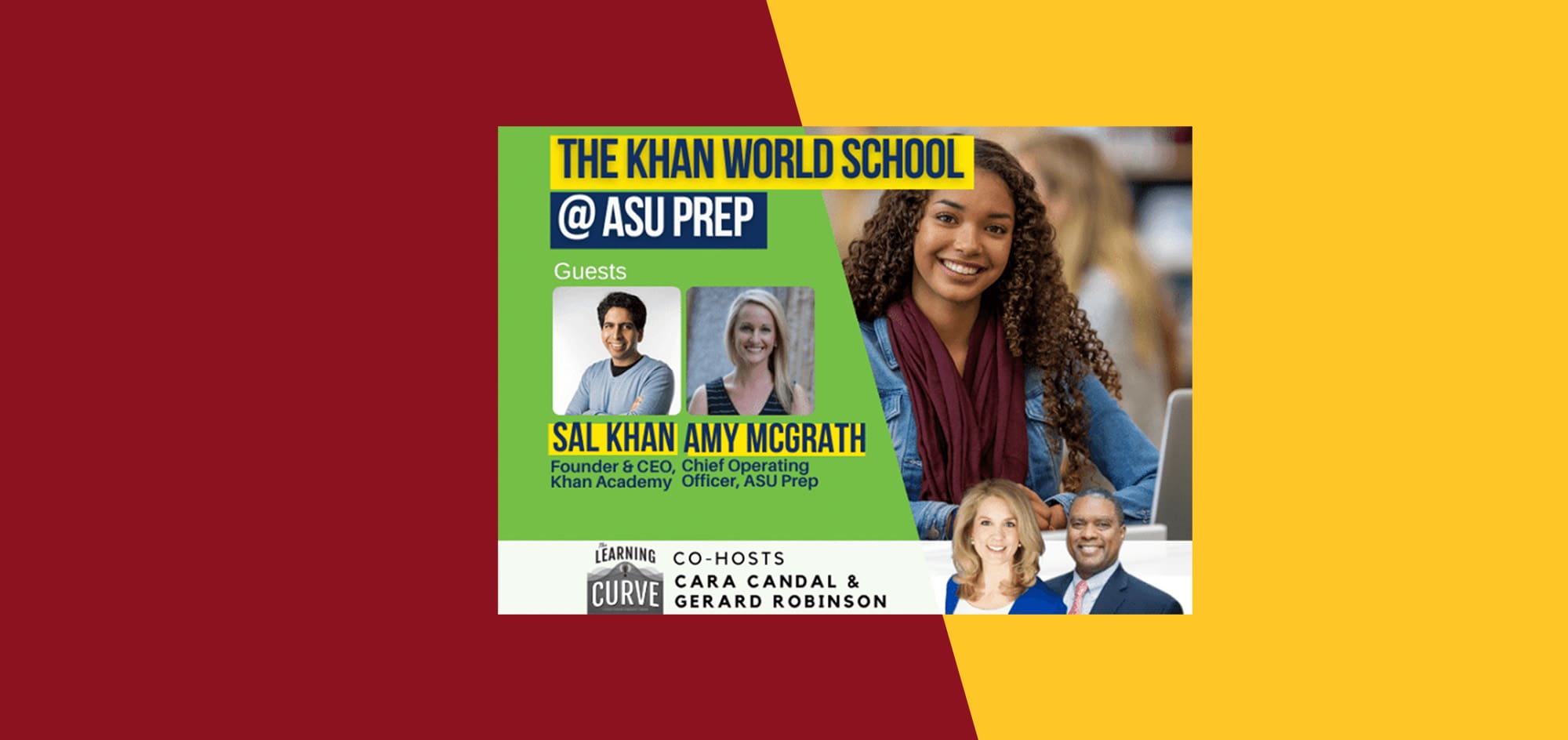ASU Prep Digital partnered with Sal Khan, founder of Khan Academy, to open a unique global online high school. Cara Candal and Gerard Robinson of “The Learning Curve,” recently interviewed Sal Khan, founder and CEO of Khan Academy, and Amy McGrath, the Chief Operating Officer of ASU Prep and Deputy Vice President of Educational Outreach and Student Services at Arizona State University. Learn more about this innovative partnership and the vision for this unique global learning model.
About Sal Khan
Sal Khan is the founder of Khan Academy, a nonprofit organization with the mission of providing a free, world-class education for anyone anywhere. Khan Academy’s content and mastery learning platform has more than 137 million registered users across 190 countries and has been localized into more than 51 languages. The organization partners with school districts across the country that serve students who are historically under-resourced. Sal holds three degrees from MIT and an MBA from Harvard. He has been profiled by 60 Minutes and was recognized as one of TIME’s 100 Most Influential People in the World.
About Amy McGrath
Amy McGrath is the Deputy Vice President of Educational Outreach and Student Services for Arizona State University and Chief Operating Officer of ASU Prep and ASU Prep Digital, ASU’s K12 network of schools. With more than15 years of experience exploring innovation and personalized learning in the field, she has a rich background which ranges from school design to marketing strategy and educational policy. A nationally recognized educational technologist, Amy prioritizes learner-centered models, and works to increase access to high-quality learning for every student, regardless of ZIP code.
Here are some segments from the podcast:
Background
SAL: “I started tutoring my 12-year-old cousin in 2004 and soon found myself tutoring 10-15 cousins. I saw many of them struggling because they had unfinished learning, gaps in their understanding. It wasn’t that they weren’t hard working. I called it Khan Academy because it was a family project. In 2005 I wrote some software and in 2006 a friend suggested I make YouTube videos to supplement the software. I gave it a shot. People who weren’t my cousin started writing to me saying it was transforming their lives.”
AMY: “At ASU Prep we believe all kids can learn and we’re laser focused on mastery models. We’re commissioned to create whatever models are needed for students across the proficiency scale. There needs to be well thought-out transformational models available. This model [Khan World School] is really geared for kids who are ready to sprint and may be bored with a traditional model. When Sal approached us there were just fireworks that went off as it was a perfect fit.”
SAL: “In 2010, Khan Academy gained notoriety, but I thought it could be more of a catalyst for education. The pandemic hit and a lot of school systems had to migrate to online learning overnight. It showed the need for taking ideas of Khan Academy and Khan Lab School and show the world there’s a way to do this. I was put in touch with Amy, and they took vision and ideas and merged thought leadership.”
Best practices
AMY: “Flexibility needs to be in the rear of newly designed models, for employees, students, families. We’re thinking of new models and outcomes of what the world needs now. So many people experienced COVID in such different ways, home, work, some were blocked from learning because they didn’t have the tools available. Our design principle is believing that every student can learn, but they all do it in different ways. If it takes you three months for algebra one, amazing. If it takes you 18 months, you have to keep going to build mastery.”
Addressing the gap
SAL: “Our system right now is very seat-time based. We put students together by age, move them through curricula at a fixed pace. Test them. Some students get a 68% but you keep moving forward. And at some point, students hit a wall. With Khan World School, students can fill in the gaps and learn and practice on their own with the video bank (Oxford-style tutorial sessions). That’s where the actual learning happens. An efficacy study showed that even at just 30 minutes a week, they’re growing 50% faster than their peers.”
Unique format
AMY: “We don’t have teachers, we have guides. From a design standpoint it has caused us to rethink the silos of learning. If society wants GPAs, this is an audacious model. But our goal is learning—learning to the point of our students explode in mastery. It changes everything. Scrap grades. You either get mastery or get an ‘in process.’ The light of mastery is our direction. Even through university level credit.”
About partnership
AMY: “It feels like a match made in heaven. We’re two very well-known organizations coming together, trying something out with the emphasis on students. The focus is away from us and onto the kids and that keeps us doing what we’re really good at bringing to the table, so it’s going to continue to play out with a lot of stories to be told and scale to happen.”
SAL: “Not to jinx it, but it is almost too good to be true. We continue to be very aligned. We push each other for what we care about. We look at how the pilot is performing and how students are prioritized in this process.”

